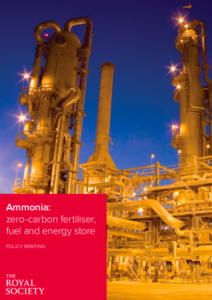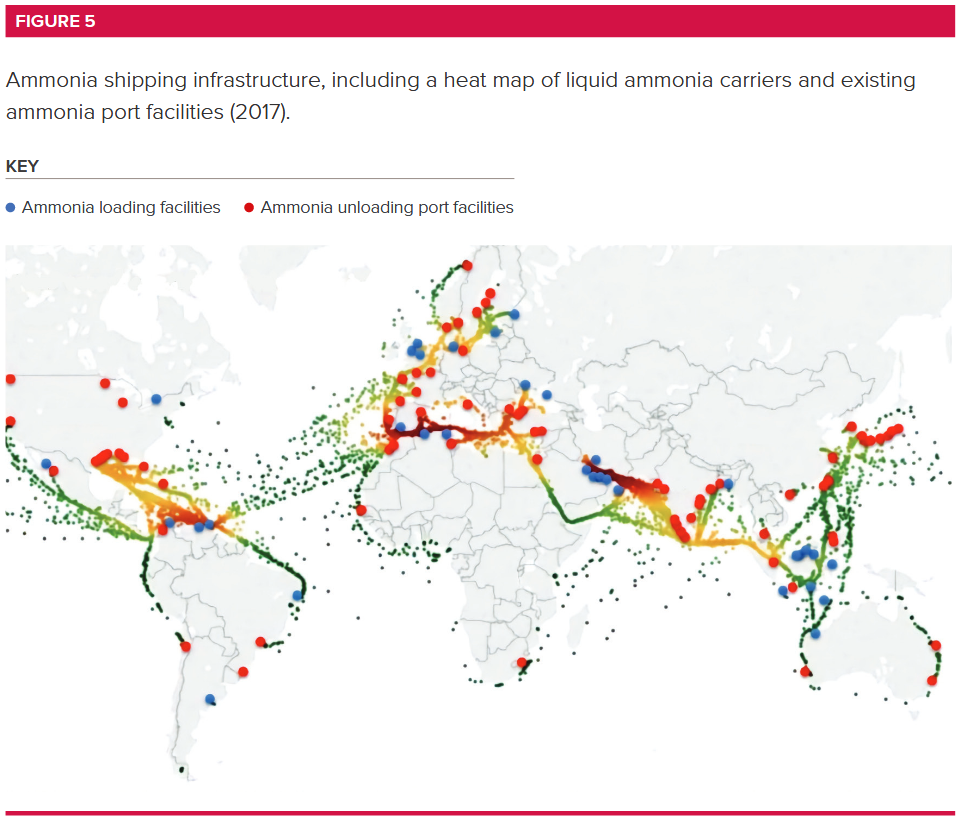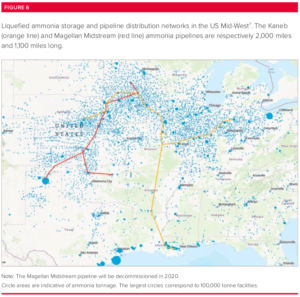Royal Society publishes Green Ammonia policy briefing
By Trevor Brown on February 20, 2020

This week, the UK’s Royal Society published an influential “Green Ammonia” policy briefing on ammonia as a “zero-carbon fertiliser, fuel and energy store.”
With its relatively high energy density of around 3 kWh/litre and existing global transportation and storage infrastructure, ammonia could form the basis of a new, integrated worldwide renewable energy storage and distribution solution. These features suggest ammonia could readily be a competitive option for transporting zero-carbon energy by road, rail, ship or pipeline.
Royal Society, Ammonia: zero-carbon fertiliser, fuel and energy store, February 2020
The executive summary succinctly communicates the responsibility required in adoption of ammonia energy — beyond immediate benefits of eliminated tailpipe CO2 emissions and immediate concerns of toxicity, to broader, more long-lasting environmental impacts.
Ammonia use does present challenges. Human alteration of the global nitrogen cycle, mainly through the application of ammonia-based fertilisers, is a contributor to global declines in biodiversity, widespread air quality problems and greenhouse gas emissions across the world. New uses of ammonia, in the storage, transportation and utilisation of renewable energy, must therefore be decoupled from environmental impact, with particular emphasis on avoiding and effectively eliminating emissions of nitrogen oxides and ammonia release.
Royal Society, Ammonia: zero-carbon fertiliser, fuel and energy store, February 2020
The function of this report, which brings together information and analysis from a wide range of sources, is to support policymakers as they move forward with developing regulatory support for ammonia within the clean energy technology portfolio.
Politics and science frequently move on vastly different timescales. A policymaker seeking evidence on a new policy will often need the answer in weeks or months, while it takes years to design and undertake the research to rigorously address a new policy question …
The Royal Society’s series of policy briefings is a new mechanism aiming to bridge that divide. Drawing on the expertise of Fellows of the Royal Society and the wider scientific community, these policy briefings provide rapid and authoritative syntheses of current evidence. These briefings lay out the current state of knowledge and the questions that remain to be answered.
Royal Society, Ammonia: zero-carbon fertiliser, fuel and energy store, February 2020
Rather than provide a comprehensive summary here — the Royal Society policy briefing is available to download — I want to focus only on four specific figures. These four illustrations repackage previously available data in valuable new ways, communicating key insights around the barriers to and opportunities for ammonia energy.
Infrastructure

One hurdle for the introduction of any new fuel is the lack of infrastructure. This creates the persistent chicken-and-egg problem: which comes first? Low availability stifles demand, while low demand throttles investment in supply.
The Royal Society policy briefing illustrates the “high level of maturity” in ammonia storage and distribution infrastructure with a world map that shows both the locations of existing import / export terminals, and a heat-map of current trade routes.
The global availability of ammonia at relevant scale today means that the infrastructure costs of fuel switching, at least in the demonstration and early adoption phase of the transition, can be largely avoided. This reduces risk for first movers: there is certainty that the fuel will be available.
While technology investments are obviously essential, the importance of fuel availability should not be ignored. Earlier this month, I wrote about the trillion dollar opportunity that the maritime sector faces, in both expanding the ammonia supply and shifting the production pathway from conventional ammonia to green ammonia. The report that I was writing about concluded that only 13% of the total cost of maritime decarbonization would be ship-side: engines, fuel systems, efficiency. In other words, technology development. The remaining 87% of investment would be spent on scaling-up fuel production to meet growing demand, through 2050.
The fact that ammonia already has a global storage and distribution infrastructure means that adoption —and global decarbonization — can be accelerated by lowering the risks and costs of demonstration and early adoption.
Perception

Another persistent hurdle to the adoption of ammonia energy, is the perception that ammonia presents unacceptable risks to health and safety. The hazard profile of ammonia must be respected and deployment must be responsible. But ammonia is not more dangerous than other fuels, and there’s no evidence that the public would not accept ammonia in communities.
The policy briefing illustrates this with a map of ammonia storage sites in the United States. There are over 10,000 ammonia storage locations across the nation, including more than 1,000 in Iowa alone, with capacity greater than the EPA’s reporting threshold. The distribution of ammonia within our communities is not limited to agricultural areas, but also densely populated urban areas, where ammonia is already widely used as, among other things, a refrigerant (ice rinks, food production and storage). This demonstrates that the existing industry can mitigate risks to satisfy even the most stringent regulations in densely populated areas, not just in the agricultural heartland.
Economics and Scale

The Royal Society report also illustrates the role of ammonia as key enabling technology for the hydrogen economy. The high costs of storing and transporting hydrogen, either as a pressurized gas or as a cryogenic liquid, create barriers to adoption. Viewing ammonia as a third distribution mode for hydrogen — pressurized, liquefied, or ammonia — opens new economic opportunities for hydrogen technologies, especially at large scale.
The report again cites the scale and technological maturity of ammonia infrastructure, stating that existing ammonia pipelines run for 4,830 km in the United States (including the Magellan pipeline, decommissioned in 2020) and 2,400 km from Russia to Ukraine.

Another chart compares transportation costs, by ship or by pipeline, again showing the clear cost advantage of ammonia relative to liquiefied (ship) or pressurized (pipeline) hydrogen.
The more complex question is: under what circumstances does this lower distribution cost overcome the additional cost of transforming hydrogen into ammonia?
The report estimates that “the cost of converting hydrogen to ammonia is around £0.80/kgH2.” Therefore, by adding this premium over hydrogen to the pipeline costs in the chart, it concludes that for energy transport beyond a distance of “around 2,500km … ammonia is cheaper.” This is fundamentally an issue of scale: while this chart analyzes costs per unit of distance; it could have drawn similar conclusions if looking at costs per unit of volume or per unit of time. At large scale, ammonia can offer significant economic advantages for storing and transporting carbon-free energy.
And to achieve meaningful decarbonization, we need scale. As the policy briefing states, summarizing recent techno-economic studies of low-carbon supply chains, “ammonia is the lowest-cost method and the most technologically-ready option for transporting energy over long distances.”